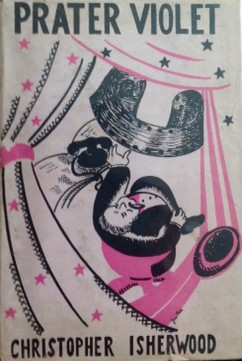Inspiring Older Readers
 posted on 14 May 2017
posted on 14 May 2017
Prater Violet by Christopher Isherwood
This novella ( it’s only a touch over a hundred pages long) packs a deceptive amount between its covers. Published immediately after the war in 1946 this represents Isherwood somewhere near the peak of his powers and links directly to his so-called Berlin novels.
Set in the early 1930s as Nazi Germany is rising to power and civil unrest is breaking out in Austria, the story concerns the making of the film Prater Violet in the UK by the charismatic Austrian film director Friedrich Bergmann for whom the semi-autobiographical, semi-fictitious Christopher Isherwood acts as script writer and general personal factotum.
The story satirises the attitudes and practices prevalent in the movie industry at the time but, as the story develops, it becomes clear that this is really an extended metaphor for British pre-war attitudes. Cynical, disengaged with the rest of the world, superficial and flippant – Isherwood points his finger at both the British establishment and the British people, asking the reader to consider what our foreign policy positions were that led to the Second World War.
Bergmann, who seeks to make his film something more than just a simple, vacuous romance, encounters resistance or lack of understanding at every turn. And when he gets news that he is stranded in the UK while his family is potentially under threat from Austrian civil strife, no decent concern is forthcoming and no understanding of his plight is allowed to invade the artificial world of the film.
Isherwood himself is caught between the two worlds – he is the one person who could make contact with Bergmann at any significant level (he’s partly hired because he speaks German) but at crucial moments he finds himself being very ’British’ and holding back, always taking the safe options.
In the end a peace of sorts breaks out in the movie studio and the film gets finished – but what is made is superficial froth. We learn that the film is a popular success but is seen as dangerous escapist nonsense by those fighting for the freedom of Europe – a way of diverting people from the true state of the world. What, Isherwood seems to be asking, is the role of the artist in these febrile and dangerous political times – should it be to distract people from the troubles or to confront them with the issues?
At the end of the novella the narrative takes an unexpected turn with the Isherwood character reflecting on what I suppose is best described as issues of existential doubt:
And behind the, most unspeakably terrible of all, the arch-fear: the fear of beign afraid…It can never be escaped; never, never. Not if you ran away to the ends of the earth. .not if you yell for Mummy, or keep a stiff upper lip, or take to drink or dope. That fear sits throned in my heart. I carry it with me always.
Post-war Europe will never again be unaware of what made the Second World War possible, what attitudes and negligence created the terror of the Nazis and, if it could happen once, it can happen again.
Chilling.
Terry Potter
May 2017